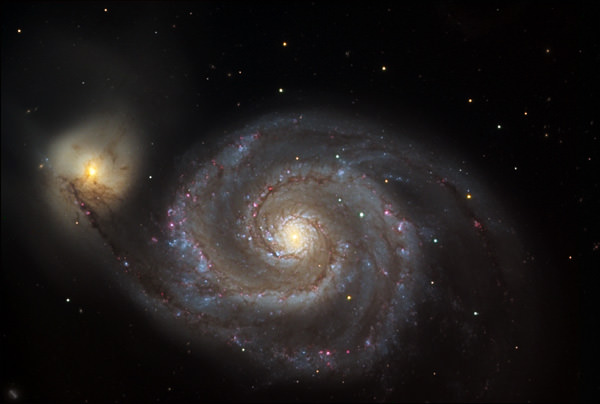[/caption]
We regularly report on the discovery of extrasolar planets in our galaxy, but earlier this year came news of possibly the first planet discovered outside of the Milky Way. Now comes news of the potential discovery of dozens of extragalactic planetary systems. Erin Mentuch and her colleagues at the University of Toronto in Canada have analyzed 88 remote galaxies and found a broad continuum excess in the near-infrared. They conclude the most likely explanation for the 2-5 micron excess is the light from circumstellar disks, or young solar systems, forming around massive young stars. “[This] presents us with an exciting opportunity to measure the formation rate of planetary systems at cosmic epochs before our own Solar System formed,” the team writes in their paper.
The light from the galaxies studied was emitted when the universe was between a quarter and half its current age – making them far too remote for their stars to be seen individually. The galaxies’ light output peaks at two distinct wavelengths. One represents the combined light of a galaxy’s stars; the other, at longer wavelengths, comes from the glow of its interstellar dust.
In each case, the team noticed a faint third component between the two peaks. Whatever produces this light is too cold to be stars and too warm to be dust. The most likely source is circumstellar discs – embryonic solar systems around young stars. “It’s the most surprising result I’ve ever worked on,” said Roberto Abraham, one of the team members.
The opportunity to study discs that existed so long ago could help reveal how the rate of planet formation across the universe has changed over time, says Mentuch.
Source: Daily Mail


what telescope did they worked with ?
anyway i can’t wait to have the JWST up and running !!
i’m sure the JWST could really help in this case
Billions and billions, as Carl Sagan kept saying.
LC
If there has been a major theme in most areas of astronomical discovery over the last few hundred years, I think it would be that things are more common than people imagine. It almost always seems to be a safe bet if we’ve found at least a few examples, many more will follow.
It would be great to see just how far we could push this technique back in time – wouldn’t it be great to be able to seriously discuss the history of the universe in regards to planetary formation, based on solid observations?!
Mmmm… Planets.
I find this article a bit hard to follow, and I think the fault is in the language. For example, there was a continuum excess, was there? As in, too much continuum? I’m really not sure what that means.
Not being pedantic; just making the point that perhaps the article is a little more terse than such an interesting topic deserves.
This excess is a larger than expected IR signature from what would be expected from just stars. This is a broad based observetion of signatures for planetary disks around stars.
LC
This is absolutely fascinating. Of course, logically, we pretty much know that almost all galaxies will have planetary systems, but somehow seeing data showing them is so much more exciting.
On the other hand, it fills me with a wistful sadness- so many worlds, and no way for us to explore them, even in our own galaxy let alone others millions of light years away. Part of me wishes I had been born in 500 or 1000 years time when, possibly, we could go to other systems (and certainly have explored our own much more). But part of me acknowledges how frakking cool it is to be alive when we are discovering these things exist for the first time- the only analogy I can think of is the discovery of America/Australia and how much BIGGER and richer that made our world, which is communicated so well in Terrence Malick’s film “The New World”.
Many thanks, Nancy, for the link to the paper. I like to read and contemplate the details of ideas and observations in papers such as this one. As LBC points out, these observations were designed to take an in-depth look at IR signatures around a wide swath of areas surrounding suspect galaxies. While not a large statistical sample yet, a clear and obvious trend is noted in the galaxies studied.
I’m betting that planets far outnumber stars.